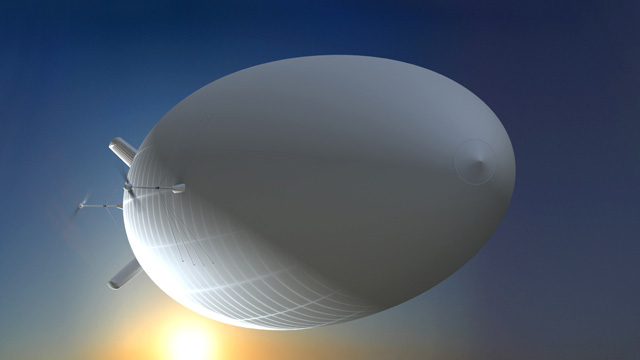Near Space Airship Fate Rests With Defense Budget

Severalcompanies have begun design work on a prototype airship that could hover at analtitude near space where it would be able to track ground and aerial targetsfor up to a year at a time. Whether the program, known as Integrated Sensor isStructure (ISIS), moves beyond the design stage any time soon, however, willdepend on the final version of the 2007 defense budget.
The U.S.House of Representatives funded the full $16.3 million request for the effortin its version of the 2007 Defense Appropriations Act, which passed the House in June. The Senate AppropriationsCommittee, however, has recommended denying the Defense Advanced ResearchProjects Agency's entire $16.3 million budget request for the program in 2007.The bill is currently awaiting a vote on the Senate floor.
The Houseand Senate will address the issue when they meet toresolve differences between their bills later this year.
Jenny Manley, a spokeswoman for theSenate Appropriations Committee, did not respond to a request for comment onthe committee's proposed cut to the ISIS program.
Jan Walker,a spokeswoman for the Defense Advanced Research Projects Agency, said thatprogram officials declined to comment on the ISIS effort at this time.
The Air Force Research Laboratory ofRome, N.Y., has awarded several contracts to industry to begin work on variousaspects of the ISIS program. The lab awarded a two-year, $10.3 million contractto Lockheed Martin Maritime Systems and Sensors of Akron, Ohio, in June tobegin work on the airship platform.
The labawarded two contracts earlier this year to Northrop Grumman Corp. for the ISISeffort. Northrop Grumman Space Technology of Redondo Beach, Calif., willdevelop a transmit-and-receive module for the radar sensor that is expected tobe lightweight and extremely power efficient under a $6.8 million contractawarded in April. Northrop Grumman's Electronic Systems sector, which is basedin Linthicum, Md., is developing an antenna that can handle radar as well astransmit data simultaneously under an $8 million contract. Raytheon Space andAirborne Systems of El Segundo, Calif., also is working on a design for the antennaunder an $8 million contract.
Breaking space news, the latest updates on rocket launches, skywatching events and more!
If theprogram does go forward, the airship, will feature a radar sensor of"unprecedented proportions," according to a Pentagon document.
The DefenseAdvanced Research Projects Agency's 2007 budget justification materials, whichare posted on the agency's Web site, describe ISIS as a sensor capable of conducting surveillanceand tracking hundreds of time-critical targets in bothurban and rural environments.
The sensoris being designed to track airborne targets at a range of 600kilometers, and ground targets at a range of 300 kilometers while distributingthat information to U.S. forces through hundreds of covert widebandcommunications links, according to the budget justification materials.
The agencywants the sensor to detect and track targets including aircraft, cruisemissiles, tanks and troops, according to briefing chartsposted on the agency's Web page. The agency also wants thesensor to detect mortar and artillery fire.
Challengesinvolved with building the system include finding ways to keep the weight, powerrequirements and logistics requirements minimal, according to the budget justification materials.
The ISISsensor would be the largest radar sensor built to date, and is much larger thanthe Sea Based X-Band Radar sensor built for the U.S. Missile Defense Agency,according to Michael Wechsberg, director of radio frequency programs and ISISprogram director at Raytheon Space and Airborne Systems.
Much of thesize of the Sea Based X-band Radar, which features a Raytheon-built sensor, ismaterial needed to keep the radar sensor stiff, Wechsberg said in a July 19interview. The company is able to avoid this issue on ISIS by using thestructure of the airship itself to stiffen the sensor, which will be placedeither inside or outside the craft, he said.
One way ofhandling the need for the antenna to transmit and receive data simultaneouslyis a technique called time multiplexing, which involves changing the functionfrom sensing to transmitting data in less than a second, Wechsberg said.
The MissileDefense Agency is developing another large airship, known as the High AltitudeAirship (HAA) that would operate at the near-space altitude, which is generallydefined as the area around 20 kilometers. Lockheed Martin is under contract to build anddemonstrate the HAA.
However,the HAA project is primarily focused on demonstrating the airship platform inthe near term, while ISIS is more focused on the payload, Wechsberg said. Thepayload aboard the HAA represents about 1.7 percent of the platform's weight,while the payload aboard ISIS accounts for roughly 30 to 40 percent, accordingto the Defense Advanced Research Projects Agency's briefing charts.
Ron Browning,HAA business development director for Lockheed Martin, said during an Aug. 1briefing for reporters that the Missile Defense Agency has not yet chosen thetype of payload that will fly aboard the HAA in its first prototype flight, butsaid that the available room could host a communications or optical sensingsystem based on mature technology that would not add risk to the HAAdevelopment effort.
The smallamount of dedicated payload space aboard the HAA means that that sensor will befar less capable than that envisioned for ISIS, Wechsberg said.
Dave Filicky, Lockheed Martin's ISISprogram manager, said that the company will be able to build on its experiencewith the HAA as it designs the ISIS platform.
However,ISIS poses its own challenges with the platform, due to the size of the sensoras well as the longer duration that it is expected to hover over particularareas.
ISIS willrequire a lighter platform to deal with the larger radar sensor, and systemsthat can operate for long periods at relatively low power, Filicky said in aJuly 19 interview.
"If itwasn't brand new, never been done before, [the Defense Advanced ResearchProjects Agency] wouldn't have funded it," Filicky said.
The HAA iscurrently expected to be demonstrated in flight for the first time around 2008;ISIS is scheduled for a reduced scale prototype flight in 2009, with plans fora full-scale demonstration to be determined afterwards, Wechsberg said.
Like ISIS,the HAA also is encountering some resistance in Congress, where members of the House and Senatehave both moved to trim the $40.1 million request for the program in 2007 inorder to steer funding towards other missile defense efforts. The House versionof the 2007 Defense Appropriations Act cuts the request for the High AltitudeAirship by $20 million, while the Senate version of the bill reduces it by $25million.
- Sky Trek To The 'Near Space' Neighborhood
- Investigation Casts Light on the Mysterious Flying Black Triangle
- UFOs and Classified Aircraft: Shedding New Light on Dark Secrets
- Components of Stars Prove the Delicacy of Life
- Lofty Goals For Higher Education: Students Build and Test Near-Space Technology
Jeremy Singer is a former journalist who specialized in stories about technology, including cybersecurity, medical devices, big data, drones, aerospace and defense. He now works as head of communications at Morse Corp, a company that creates algorithm development, software development and system integration services to solve issues in the aerospace industry.
